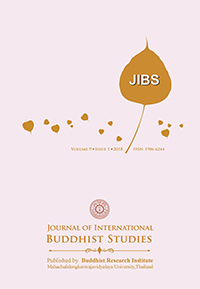Buddhism and Holistic Education
Abstract
This paper attempts to integrate the perspective of holistic education (a postmodern view of education) with Buddhist worldviews. It describes “the five dimensions of reality” that include objective reality, social reality, cosmic reality, infinite reality, and universal reality, referring to ideas derived from Mahayana Buddhist thought. Holistic education is defined as an attempt to explore the multiple dimensions of reality in our existence. It involves ideas such as “awakening” (bodhi) and “enlightenment” (satori) at its core. Therefore, Buddhism plays a central role in the development of holistic education by providing such concept as “enlightenment education” (Thurman).
References
Badiner, Allan Hunt. ed. Dharma Gaia: A Harvest of Essays in Buddhism and Ecology. Berkeley: Parallax Press. 1990.
Barrett, William. ed. Zen Buddhism: Selected Writings of D. T. Suzuki. New York: Doubleday. First published . 1996.
Blofeld, John. trans. The Zen Teachings of Huang Po.New York: Grove Press.Cleary, Thomas. trans. 1993.The Flower Ornament Scripture: A Translation of The Avatamsaka Sutra. Boston: Shambhala Publications. 1958.
———. trans. The Sutra of Hui-neng: Grand Master of Zen. Boston: Shambhala Publications. 1998.
Garfield, Jay L. trans. The Fundamental Wisdom of the Middle Way: Nāgārjuna’s Mūlamadhyamakakārikā. New York: Oxford University Press.Hakeda, 1995.
Yoshito.trans. The Awakening of Faith. New York: Columbia University Press. 1967.
Haskel, Peter. trans. Bankei Zen: Translations from the Record of Bankei. Edited by YoshitoHakeda. New York: Grove Weidenfeld. 1984.
Inagaki, Hisao, et al., eds. A Record in Lament of Divergences: A Translation of the Tannishō. 2nd ed.Kyoto:
Jodo ShinshuHongwanji-ha. 2005.
Izutsu, Toshihiko. The Structure of Oriental Philosophy: Collected Papers of the Eranos Conference. Vol. I. Tokyo: Keio University Press. 2008.
——— The Structure of Oriental Philosophy:
Collected Papers of the Eranos Conference. Vol. II. Tokyo: Keio University Press. 2008.
Nakagawa, Yoshiharu. Education for Awakening: An Eastern Approach to Holistic Education. Brandon, VT: Foundation for Educational Renewal. 2000.
———. “Aldous Huxley: A Quest for the Perennial Education.” Chapter 10 in Nurturing Our Wholeness: Perspectives on Spirituality in Education, edited by John P. Miller and Yoshiharu Nakagawa. Brandon, VT: Foundation for Educational Renewal. 2002.
———.“The Child as Compassionate Bodhisattva and
as Human Sufferer/Spiritual Seeker: Intertwined Buddhist Images.” Chapter 3 in Nurturing Child and Adolescent Spirituality: Perspectives from the World’s Religious Traditions,edited by Karen Marie Yust, et al. Lanham, MD: Rowman& Littlefield. 2006.
———. “Eastern Wisdom and Holistic Education: Multidimensional Reality and the Way of Awareness.” Chapter 9 in Cross-Cultural Studies in Curriculum: Eastern Thought, Educational Insights, edited byClaudia Eppert and Hongyu Wang. New York: Lawrence Erlbaum Associates. 2008.
———.“Awareness and Compassion for the Education
of Enlightenment.” Chapter 31 in International Handbook of Education for Spirituality, Care and Wellbeing, edited by Marian de Souza, et al. Dordrecht, Germany: Springer. 2009.
———.“Oriental Philosophy and Interreligious
Education: Inspired by Toshihiko Izutsu’s Reconstruction of ‘Oriental Philosophy’.” Pp. 325- 339 in International
Handbook of Inter-religious Education, edited by Kath Engebreston, et al. Dordrecht, Germany: Springer. 2010.
———.“A Multidimensional View of Holistic
Education: From Eastern Perspectives.” Pp. 85-96 in Creating New Science for Human Services.Kyoto: Graduate School of Science for Human Services, Ritsumeikan University. 2011.
———.“A Dialogue between Holistic and Integral Orientations in Postmodern Education: Toward a Multidimensional Perspective.” Pp. 208-236 in Kyōiku-bunka[Journal of Education and Culture], No. 22, Kyoto: The Department of Education and Culture, Doshisha University. 2013.
Nakamura, Hajime. Ways of Thinking of Eastern
Peoples: India, China, Tibet, Japan.Edited by Philip P. Wiener. Honolulu: The University of Hawaii. First published 1964. 1978.
Seng-Ts’an. “On Trust in the Mind.” Translated by
Burton Watson. Chapter 12 in Entering the Stream: An Introduction to the Buddha and His Teachings, edited by Samuel Bercholz and Sherab Chödzin Kohn. Boston: Shambhala Publications. 1993.
Simmer-Brown, Judith, and Grace, Fran.eds. Meditation and the Classroom: Contemplative Pedagogy for Religious Studies. Albany, New York: State University of New York Press. 2011.
Suzuki, DaisetzTeitaro. The Essence of Buddhism.rev. ed. Kyoto: Hozokan. 1948.
Tanahashi, Kazuaki. ed. Moon in a Dewdrop: Writings
of Zen Master Dōgen. New York: North Point Press. 1985.
Thurman, Robert. Inner Revolution: Life, Liberty, and
the Pursuit of Real Happiness. New York: Riverhead Books. 1998.
Tucker, Mary Evelyn, and Williams, Duncan Ryūken. eds. Buddhism and Ecology: The Interconnection
of Dharma and Deeds. Cambridge, MA: Harvard University Press.1997.
Watson, Burton. trans. The Zen Teachings of Master Lin- chi. Boston: Shambhala Publications. 1993.







